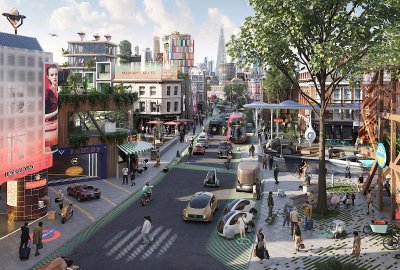Profits from today’s car sales fund the development of their replacements. Every car company’s research and development team is tasked with planning and innovating for the future though the extent of those strides varies greatly.
Mercedes-Benz is all-in on the future, and wasn’t shy about showing off the innovations the company is working on. Many are likely to make their way into production in some form or another in the next decade, if even in small scale.
“Innovation has always been the key driver for our core principles: safety, quality, comfort and design. It’s part of our DNA,” Eileen Böhme, director of strategy, innovations and future technologies research and development at Mercedes-Benz AG, told Newsweek during a presentation in Germany.
“Leading technologies means iconic design, and this is what we’ve always done, and this is what we will always continue to do. Under the theme of progress, you will see innovation… It’s innovation in a different manner, because we are not just talking about innovation and tech. We’re talking about it in the surrounding of society and human needs. So, we will balance the new technology with the human needs and see how and how we match them in the end,” she said.
The automaker has spent close to €74 billion on research and development for its Cars and Vans devisions over the last decade, making it one of the highest spenders in the automotive industry.

Mercedes-Benz

Mercedes-Benz
Results have yielded transitional car models and powertrains, but the biggest impact bits are yet to come. The company previewed many of them during a two-day, media-only technology presentation at the home of Mercedes R&D in Germany.
Harvesting solar power in untraditional ways
A future Mercedes may not be solar powered, but it may be able to harvest a significant amount of energy from the sun to fulfill its daily driver needs, and more depending on its parked location.
Here’s how it works. Solar modules are applied to the bodywork of an electric vehicle in a process akin to applying a wafer-thin layer of paste. In its current form, it cannot be applied like the paints the company uses on its current vehicles.
The modules are small, significantly thinner than a human hair, the company said. They weigh 50 grams per square meter. On an area of 118.4 square feet, about the surface of a mid-size sport utility vehicle, the solar cells could produce energy to propel a vehicle up to 7,456 miles per year. The average American travels 14,263 miles annually according to the Federal Highway Administration.
With an efficiency of 20 percent the modules are about as efficient as a home’s rooftop solar panels. They generate energy even when a vehicle is parked.
When a car covered in the cells has reached the end of its life, the cells are, “easy to recycle.” On top of that, they are, “considerably cheaper to produce than conventional solar modules,” a Mercedes representative said.
Changing your view with augmented reality
No need for a head-up display and no need to miss a text, email or Teams message. It sounds too good to be true, but it could be the future of Mercedes-Benz vehicles.
In a decade, augmented reality glasses have gone from large, cumbersome headsets to technology fitting into thick frames akin to something Clark Kent would wear as a disguise. The technology is becoming increasingly applicable and less expensive as well.

Mercedes-Benz

Mercedes-Benz
Taking the “Bring Your Own Device” (BYOD) approach, customers would be able to wear their AR glasses in their vehicle. When they were worn within a Mercedes model, they would adapt to the actions being performed, displaying driving and infotainment information, controllable via eye gaze, allowing a driver to never take their eyes off the road to look at an infotainment screen.
Mercedes engineers told Newsweek that glasses in a form that would be compatible with the brand’s vehicle are likely three years out based on what suppliers have told them.


